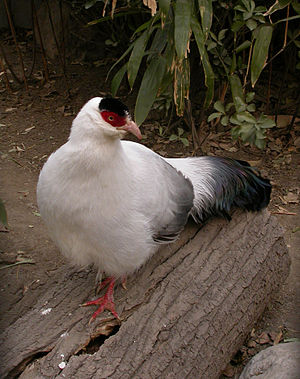White ear pheasant
| White ear pheasant | ||||||||||
|---|---|---|---|---|---|---|---|---|---|---|

White ear pheasant |
||||||||||
| Systematics | ||||||||||
|
||||||||||
| Scientific name | ||||||||||
| Crossoptilon crossoptilon | ||||||||||
| ( Hodgson , 1838) |
The White hoki ( Crossoptilon crossoptilon ) is a bird art from the family of pheasant-like . It is native to the Chinese provinces of Yunnan , Sichuan and Qinghai as well as in Tibet and the far northeast of India , where it mainly inhabits mountain forests. Sometimes the Harman's ear pheasant, which is widespread in Tibet, is also considered a subspecies of the white ear pheasant.
description
The nominate form of the white ear pheasant is predominantly white. The rather large and heavy pheasant species has a velvety black head cap that extends to the middle part of the head. The iris is orange-yellow, the bill pink-horn-colored. The area around the eye is featherless and intensely red. The ear covers are somewhat elongated, but do not form tufts of feathers protruding far behind the head as in other ear pheasants. Upper wing and upper tail ceilings are tinted gray. The arm wings are black-brown with a reddish steel-blue sheen, the hand wings are dark brown. The tail includes twenty control feathers and shines purple-bronze on the basal part, green-blue on the middle part and deep purple at the end. In contrast to the other species of the genus, the middle tail feathers of this species and the Harman's ear pheasant are not torn up like hairs, but only loosened from the base to the middle. The feet are dark red.
The sexes do not differ externally, the hen is only 1.5 to 1.8 kg lighter than the 1.8–2.2 kg heavy rooster. The body length is 920 mm, that of the tail 575 mm. The wing length is 330 mm.
voice
The courtship call is a rough, widely audible series of calls that begins with individual tones and then increases. It is practically indistinguishable from that of the Harman ear pheasant, but it is performed a little faster.
Distribution and geographic variation
The white-eared pheasant is found in western China, Tibet and the far northeast of India.
The geographical variation is quite pronounced, but little studied, so that so far only a few subspecies have been distinguished. The nominate form is predominantly white, the dolani subspecies light ash gray. The birds of the subspecies drouynii are quite inconsistent pure white or light gray, it probably mediates between the two other subspecies. Sometimes the Harman ear pheasant is also placed in this species, the body fletching of this is dark slate blue. The subspecies lichiangense, which is sometimes listed and described by Jean Théodore Delacour , is probably assigned to the nominate form.
- C. c. crossoptilon ( Hodgson , 1838) - western Sichuan, northwestern Yunnan, southeastern Tibet, and extreme northeastern India
- C. c. dolani Meyer de Schauensee , 1938 - southern Qinghai
- C. c. drouynii Verreaux , 1868 - extreme southwest of Qinghai and eastern Tibet
habitat
The white-eared pheasant is a typical bird of the eastern Tibetan mountain forests. It occurs here mainly in light coniferous and oak forests on steep slopes between 3200 and 4200 m altitude, but also in other forest forms and at lower altitudes. At the tree line around 4600 m it populates rhododendron populations . In the area of the Yangtze and its tributaries, it inhabits rocky, steep slopes with bush vegetation of sparrows , wild roses , barberries , prunus species and junipers between 3500 and 4000 m. In winter he is also in the cultural landscape.
literature
- Steve Madge , Phil McGowan : Pheasants, Partridges & Grouse. Helm Identification Guides, London 2002, ISBN 0-7136-3966-0 .
- Heinz-Sigurd Raethel : Chicken birds of the world. Verlag J. Neumann-Neudamm GmbH & Co. KG, Melsungen 1988, ISBN 3-7888-0440-8 .
Web links
- Crossoptilon crossoptilon in the endangered Red List species the IUCN 2008. Posted by: BirdLife International, 2008. Accessed on 30 September, 2010.
- Videos, photos and sound recordings about Crossoptilon crossoptilon in the Internet Bird Collection
- Crossoptilon photos crossoptilon in the Oriental Bird Club image database , accessed on September 30, 2010
- xeno-canto: Sound recordings - White Eared Pheasant ( Crossoptilon crossoptilon )
Individual evidence
- ↑ XC23942 · Weißer Ohrfasan · Crossoptilon crossoptilon audio sample on xeno-canto.org